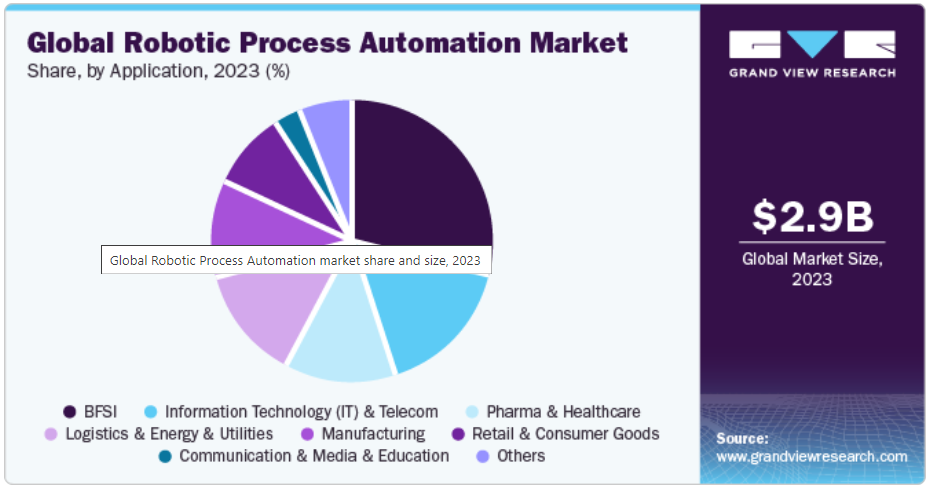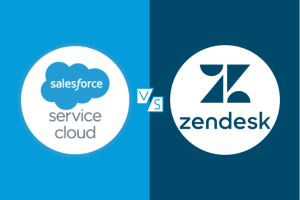Since its emergence in the early 2000s, robotic process automation (RPA) has transformed rule-based tasks in banking and insurance. But did you know that as technology advanced, RPA’s role has expanded beyond just automation? Today, it’s pivotal in maintaining operational efficiency. With a market value of US$ 3.3 billion in 2023 and expected growth to US$ 11.9 billion by the next decade, the demand for AI and RPA development services is surging. (Source)
This urgent need for automation saw industry giants like Google partnering with companies like Automation Anywhere, innovating platforms that allowed businesses to design and develop their own AI and RPA solutions.
Such collaborations not only addressed automation challenges but also set the stage for a significant acceleration in AI and RPA adoption.
This blog will explore the utility of AI and RPA in transforming business processes in detail. It will familiarize you with intelligent process automation, key ways in which it has been transforming business, and the ethical considerations of implementing AI and RPA.
AI and RPA: A Synergistic Approach to Business Transformation
From a process automation point of view, AI and RPA aren’t just mutually beneficial; they are also interdependent.
Think of AI as the brain of business automation; it’s the instructor who handles & analyzes volumes of data, identifies patterns, learns from them, predicts future states, and instructs the system. RPA, on the other hand, functions as the body, executing all instructions across diverse systems and applications. It is the medium through which AI accomplishes repetitive, rule-based activities.
When they’re not in sync, automated business processes do not function optimally. For instance, AI handles complex data and generates insights/decisions based on it. If RPA isn’t aligned to follow through on these decisions, it will lead to delays, errors, and inefficiencies. Similarly, if RPA systems are optimized to act, but AI passes on inaccurate information, the output will be counterproductive.
Their synergy is crucial, and it leads to what’s known as Intelligent Process Automation (IPA).
Intelligent Process Automation
Contrary to standard automation, IPA refers to a complete, intelligent system where automated processes are continuously optimized as per AI-generated insights and predicted future states. This enables business processes to learn and adapt over time, improving the overall effectiveness of your workflows.
How are AI and RPA Transforming Businesses?
AI and RPA are improving business processes in several ways, including:
Ease of Scaling
Implementing AI and RPA together simplifies scaling in several ways, including:
- They automate repetitive, time-consuming tasks across multiple departments. Furthermore, scaling this automation is simple. Given its modular nature, these systems can add more features and resources without interfering with already-existing workflows.
- A deployable ‘digital workforce’ is used by AI-integrated RPA systems. Unlike human workers, these bots work around the clock with minimal downtime. As the workload increases, more bots can simply be added by replicating the existing programs wherever necessary.
- Many RPA systems are cloud-based. Being hosted on the cloud enables them to dynamically adjust resources as per demands, making it easier for you to scale up or down without changing physical infrastructure.
Improved Customer Experiences
AI-integrated automation systems are transformative in enhancing customer experiences as well as backend processes. Here’s how:
- AI and RPA systems often have natural language processing capabilities, allowing them to comprehend consumer queries with some contextual understanding. This ability enables bots to generate personalized, human-like responses, delivering a consistent CX.
- These systems can smartly automate backend processes to deliver real-time services. Whether recording an inquiry, processing a transaction, or scheduling an appointment, these systems respond swiftly. Such prompt action helps reduce response and wait times, enhancing overall customer satisfaction.
- NLP-powered AI and RPA systems can also offer multilingual support, broadening the reach of your services. This can help you expand across borders and regions without the need for setting up physical branches or hiring multilingual staff.
Cross-Platform Integration
AI and RPA systems are very effective in connecting and synchronizing workflows across different applications and platforms.
- They integrate disparate systems using custom APIs, middleware, and data integration tools to create a unified workflow that eliminates the need for manual data handling or transfer.
- They can also effectively automate processes with multiple systems. For example, a customer’s information could be automatically updated across all customer service platforms when a change is made in one, ensuring consistency and accuracy.
Enhanced Volume-Handling Capacity
Another key advantage of implementing AI and RPA together is enhanced volume-handling capacity. These systems are configured to accommodate an increase in workload without a proportional increase in resources. This is largely due to the digital workforce these systems employ, consisting of bots that can be quickly replicated and deployed as needed.
Unlike human workers, RPA bots can operate around the clock without fatigue or breaks. This continuity significantly improves the capacity, especially in customer service-centric industries where inquiries might come in at all hours.
These systems operate significantly faster than human workers, completing tasks in minutes that might take hours for a human. Moreover, they achieve this with a much lower risk of errors.
Compliance and Risk Management
AI and RPA implementation can also help with risk management. It can automate regulatory reporting with greater precision, minimizing errors associated with human handling. Additionally, by continuously monitoring these reports, AI systems can identify and address compliance issues in real time. On the other hand, RPA can help in creating detailed audit trails, simplifying the process of conducting audits. This makes it easier to adhere to security and quality standards.
Key Industries Transformed by Intelligent RPA
As of 2023, the adoption of AI and RPA was majorly seen in BFSI and the IT & Telecom industries. Here’s a rough breakdown as per Grandview research:

(Source)
Most Common Applications within Each Industry
| Industry | Specific AI and RPA Use Cases |
| Banking, Financial Services, and Insurance |
|
| IT & Telecom |
|
| Pharma & Healthcare |
|
| Logistics |
|
| Energy & Utility |
|
| Manufacturing |
|
| Retail & Consumer Goods |
|
| Communication & Media |
|
| Education |
|
Challenges vs. Solutions: Implementing AI and RPA
Transitioning to a new system often comes with certain challenges. Likewise, integrating AI and RPA solutions into your existing workflows is also complex. Here is why.
Challenge #1: Resistance from Stakeholders
Implementing AI and RPA may be resisted by stakeholders due to their fear of change and uncertainty. These technologies often accompany concerns because employees anticipate that their implementation could result in reduced employment opportunities, especially in established, labor-intensive businesses.
Solution: Getting early input from stakeholders and other involved individuals will help you raise awareness of the benefits of implementing AI and RPA solutions, both to the organization and to people. Clearly explain, using appropriate examples, how this technology can facilitate their job and promote an innovative culture.
Challenge #2: Integration Complexity
Many companies have established workflows, often built on legacy systems and applications. Integrating AI and RPA into these systems can be complex due to compatibility issues.
Solution: You can adopt a phased approach to modernize your legacy systems by upgrading certain elements. This systematic approach, which begins with non-essential functions before moving on to key operations, reduces interruptions and facilitates the process. For a smooth transition, you can also devise an integration strategy with the assistance of a reputable RPA consulting services company.
Challenge #3: Data Quality and Availability
AI and RPA solutions are effective only if the systems are trained on high-quality, well-organized data. Many organizations struggle with data that is siloed, outdated, or poorly maintained.
Solution: Focus on data management. Begin by cleaning existing data to remove inaccuracies and inconsistencies. Then, consolidate this cleaned yet siloed data into a centralized system to simplify access. Establish a comprehensive data governance framework to oversee the quality and security of data. This framework should include clear policies and procedures for data entry, storage, and management. If you lack the time or resources, you can also seek professional help for data management.
Challenge #4: Budget Constraints
Preparing your existing infrastructure to integrate AI and RPA often requires upfront investment in modern technologies, staff training, etc. This is a common hurdle for budget-conscious organizations.
Solution: To optimize your budget for AI and RPA integration, start by identifying the integration scope. Build a strong case highlighting the precise benefits of implementing RPA solutions in those areas with a focus on ROI. Moreover, start with smaller, less costly projects to observe actual ROI improvements.
Challenge #5: Skill Shortage
As these technologies are still evolving, there is often a shortage of specialized skills needed for AI and RPA deployment. Employees must not only be familiar with these technologies but also understand the business logic behind their integration.
Solution: Implement internal training programs to retrain your employees and upskill them with the latest technical skills. You can also work with external experts or consultancies to fill these gaps by hiring temporary employees. There’s another option, you can also outsource RPA development services. These service providers can handle the entire process, from scope definition to custom development and deployment.
Responsible AI and RPA Implementation
Successful and responsible AI and RPA implementation is non-negotiable if you want to maximize their benefits while sidestepping potential risks. It requires careful consideration and planning to address ethical concerns, ensure data privacy, and maintain transparency throughout the process. Below is a list of some key aspects to focus on.
Ethical Use
You must ensure that the AI algorithms you implement are designed to avoid biases. During the AI development phase, incorporate mechanisms to identify and rectify them. Conduct regular audits and test AI systems for potential discriminatory outcomes by running simulations and then analyzing their actions across different scenarios.
Human-AI Balance
While AI and RPA implementation improves your business processes efficiently, their provisional understanding might fall short in complex or critical scenarios that require nuanced human judgment. This is why, maintaining a balance between automation and human oversights is crucial. Humans should be able to review and intervene in AI and RPA processes whenever necessary.
Transparency and Explainability
Your AI and RPA decisions should be transparent and explainable. Communicate how these technologies will improve existing processes and provide detailed explanations for their decisions. For instance, if an AI system denies a loan application, outline the criteria and logic used to reach that decision. This helps users understand the reasoning behind outcomes, builds trust, and ensures that the technology is used fairly and effectively.
Impact on Workforce
Ever since the AI explosion, people have been worried about getting replaced. This is because AI-powered automation has significantly altered several job roles by taking over repetitive and routine tasks. To address this issue, keep your employees informed about how their roles will evolve rather than disappear. Offer reskilling and upskilling opportunities to help them transition to new workflows. Once they understand these changes, they’ll likely find that intelligent automation can actually boost job satisfaction by allowing them to focus on more meaningful work.
Future Outlook
Looking ahead, AI and RPA are set to redefine business operations far beyond simple automation and crisis management. These technologies will evolve to become essential, sophisticated components of efficient business practices. Yet, this progress highlights the indispensable role of human oversight in steering AI and RPA-driven processes. As intelligent software robots work more closely with people, the focus will shift towards fostering a dynamic AI-human synergy. This exciting interplay of technology and human ingenuity will thus define the future of work. Stay tuned to see how it pans out.


